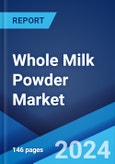Whole milk powder is derived by removing water from fresh pasteurized, homogenized, or non-homogenized milk through evaporation or spray-drying. It can also be manufactured by blending fluid, condensed, or non-fat dry milk with liquid or dry cream. It is characterized by a creamy flavor, light cream color, and pleasing taste. Its moisture is removed, which further assists in inhibiting microbial growth and providing the same nutritional properties as regular milk. Moreover, as it is easy to handle, store, and disperse in water, has a long shelf-life, and provides a cost-efficient source of milk fats, it is widely utilized in manufacturing a wide range of food products.
Whole Milk Powder Market Trends
The flourishing food and beverage (F&B) industry represents one of the significant drivers positively influencing the use of whole milk powder in recombined milk, baby food and infant formulas, and energy foods, beverages, and toppings. In addition, the escalating demand for baby food and infant formulas on account of the busy lifestyle of working parents and their rising concerns about the overall development of their children is contributing to the market growth. Apart from this, whole milk powder is widely utilized as a source of non-fat milk solids in baked and confectionery goods. This, along with the growing popularity of milk powder in regions with low availability of milk and the introduction of organic and lactose-free variants, is strengthening the market growth. Besides this, manufacturers are offering vitamin-fortified whole milk powder for direct use in milk beverages, yogurt, coffee, and tea whitener. Furthermore, the easy availability of different product flavors in instant, organic, and low-fat variants through e-commerce channels is impelling the market growth.Market Segmentation
This report provides an analysis of the key trends in each sub-segment of the global whole milk powder market report, along with forecasts at the global and regional level from 2025-2033. The report has categorized the market based on end use.Breakup by End Use
- Dairy
- Infant Formulae
- Bakery
- Confectionery
- Others
Breakup by Region
- New Zealand
- China
- European Union
- Brazil
- Argentina
- Others
Competitive Landscape
The competitive landscape of the market has been analyzed in the report, along with the detailed profiles of the major players operating in the industry. Some of these players are Lactalis International, Nestlé S.A., Fonterra Co-operative Group Limited, Royal FrieslandCampina N.V., and Danone S.A.The study, which has been done by one of the world’s leading research and advisory firms, covers all the requisite aspects of the whole milk powder industry. This ranges from macro overview of the market to micro details of the industry performance, manufacturing requirements, project cost, project funding, project economics, expected returns on investment, profit margins, etc. This report is a must-read for entrepreneurs, investors, researchers, consultants, business strategists, and all those who are planning to foray into the whole milk powder industry in any manner.
Key Questions Answered in This Report
1. How big is the whole milk powder market?2. What is the future outlook of whole milk powder market?
3. What are the key factors driving the whole milk powder market?
4. Which region accounts for the largest whole milk powder market share?
5. Which are the leading companies in the global whole milk powder market?
Table of Contents
Companies Mentioned
- Lactalis International
- Nestlé S.A.
- Fonterra Co-operative Group Limited
- Royal FrieslandCampina N.V.
- Danone S.A
Methodology

LOADING...
Table Information
| Report Attribute | Details |
|---|---|
| No. of Pages | 143 |
| Published | February 2025 |
| Forecast Period | 2024 - 2033 |
| Estimated Market Value in 2024 | 6.57 Million Tons |
| Forecasted Market Value by 2033 | 8.4 Million Tons |
| Compound Annual Growth Rate | 2.8% |
| Regions Covered | Global |
| No. of Companies Mentioned | 5 |









